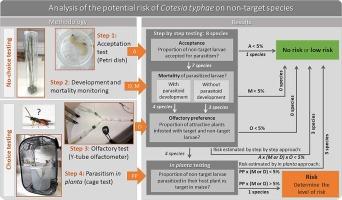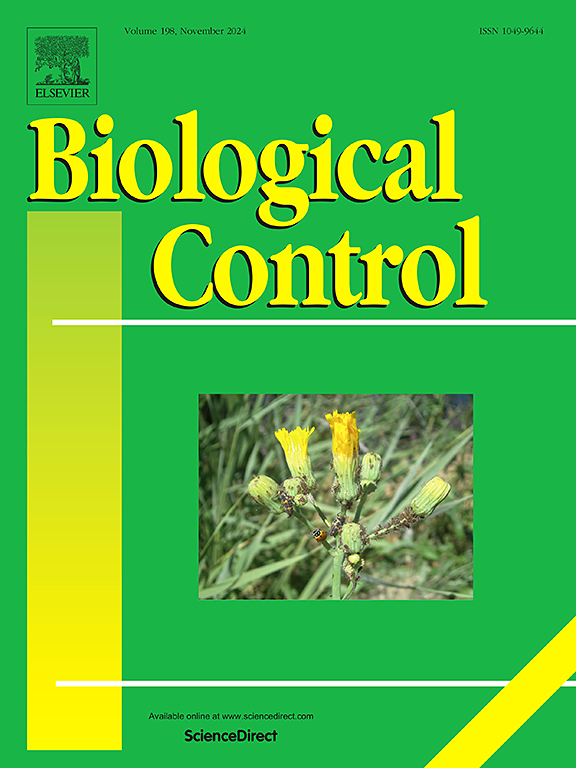地中海玉米螟潜在生物控制剂 Cotesia typhae 的非目标风险评估
IF 3.4
2区 农林科学
Q2 BIOTECHNOLOGY & APPLIED MICROBIOLOGY
引用次数: 0
摘要
外来害虫的生物控制可以通过引入本地的天敌来实现。这种方法在全球范围内成功控制了许多害虫,但有时也会对当地的非目标害虫产生负面影响。根据欧盟规定,在引进用于作物保护的外来大型生物之前,必须进行风险评估。在这项研究中,我们评估了幼虫寄生虫 Cotesia typhae(膜翅目,腕足动物)的非目标风险,该寄生虫是地中海玉米螟 Sesamia nonagrioides(鳞翅目,夜蛾科)的潜在淹没式生物控制剂,这两种害虫都是撒哈拉以南非洲的原生生物。通过实验室条件下的连续分析,包括接受测试、发育监测、嗅觉吸引力和植物寄生测试,确定了谷斑皮蠹对 8 种非目标物种的影响。不同物种的结果差异很大。通过乘以寄生过程中各个步骤的结果概率,我们估计非目标物种与 S. nonagrioides 幼虫(分别为 41% 和 42%)相比,谷斑皮蠹幼虫的平均发育风险(非目标幼虫的 1%)和诱导死亡风险(5%)较低。在植物体内观察到的死亡率最高的是香蒲螟(Nonagria typhae)(9%),但仍低于目标物种(33%)。这些寄主范围结果和寄生虫在冬季温度下的低存活能力表明,长期环境风险较低,van Lenteren 等人(2003 年)提出的全球风险指数估算也证实了这一点。台风蓟马在田间条件下的寄主范围和影响将很快确定。本文章由计算机程序翻译,如有差异,请以英文原文为准。

Non-target risk assessment of Cotesia typhae, a potential biological control agent of the Mediterranean corn borer
Biocontrol of exotic insect pests can be achieved by introducing natural enemies from the native range. This method has been successful in controlling many pests worldwide, but negative effects on local non-targets have sometimes occurred. Before the introduction of exotic macro-organisms useful for crop protection, a risk assessment is mandatory under EU regulations. In this study, we assessed the non-target risks of the larval parasitoid Cotesia typhae (Hymenoptera, Braconidae), a potential agent for inundative biocontrol of the Mediterranean corn borer Sesamia nonagrioides (Lepidoptera, Noctuidae), both natives to Sub-Saharan Africa. The effects of C. typhae on 8 non-target species was determined by sequential analysis under laboratory conditions, including tests of acceptance, development monitoring, olfactory attractiveness and in planta parasitism test. The results varied considerably between species. By multiplying the probability of outcome of the successive steps of the parasitism process, we estimated that non-target species had lower average risks of C. typhae development (1 % of non-target larvae at risk) and of induced mortality (5 %) compared to S. nonagrioides larvae (41 and 42 % respectively). The highest mortality risk in planta was observed for the cattail stemborer, Nonagria typhae (9 %), although it was still lower than for the target species (33 %). These host range results and the low survival capacity of the parasitoid at winter temperatures, suggest a low long-term environmental risk, which is supported by the estimation of the global risk index proposed by van Lenteren et al. (2003). The host range and impact of C. typhae in field conditions will soon be determined.
求助全文
通过发布文献求助,成功后即可免费获取论文全文。
去求助
来源期刊

Biological Control
生物-昆虫学
CiteScore
7.40
自引率
7.10%
发文量
220
审稿时长
63 days
期刊介绍:
Biological control is an environmentally sound and effective means of reducing or mitigating pests and pest effects through the use of natural enemies. The aim of Biological Control is to promote this science and technology through publication of original research articles and reviews of research and theory. The journal devotes a section to reports on biotechnologies dealing with the elucidation and use of genes or gene products for the enhancement of biological control agents.
The journal encompasses biological control of viral, microbial, nematode, insect, mite, weed, and vertebrate pests in agriculture, aquatic, forest, natural resource, stored product, and urban environments. Biological control of arthropod pests of human and domestic animals is also included. Ecological, molecular, and biotechnological approaches to the understanding of biological control are welcome.
 求助内容:
求助内容: 应助结果提醒方式:
应助结果提醒方式:


